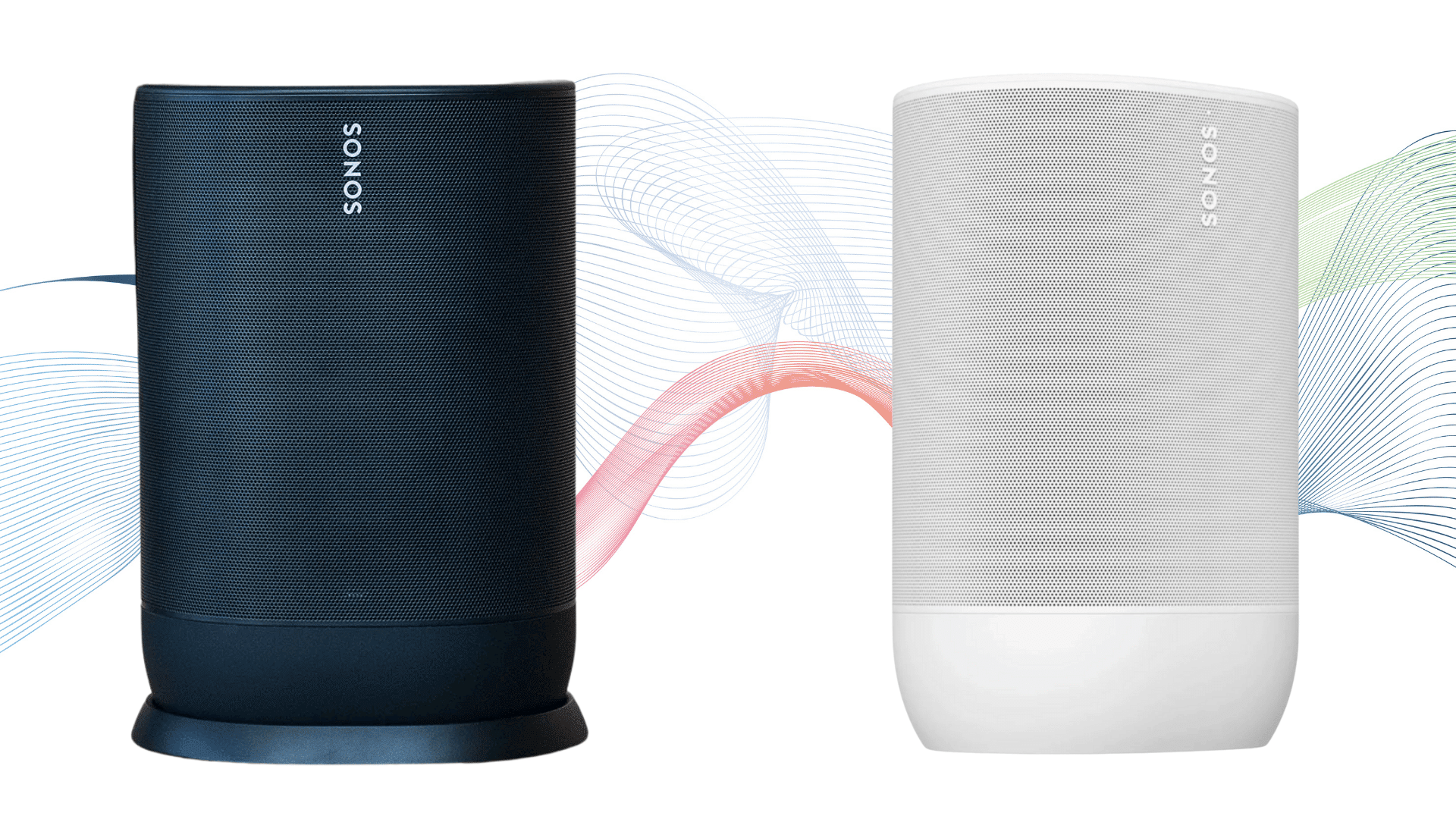If you’ve been trying to decide between the Sonos Move vs. Move 2, you’re not alone.
I’ve been there too – comparing specs, reading reviews, and wondering if the newer Move 2 truly offers enough to justify its price. Both look similar at a glance, but the details tell a different story.
In this blog, you’ll see how both stack up in features. I’ve broken down what actually changed, what stayed the same, and which one makes more sense for your setup.
After reading this, you’ll know exactly which Sonos speaker fits your listening habits – without getting lost in the specs. Let’s get into it.
Sonos Move vs. Move 2: Key Specs
Sonos Move and Move 2 are portable smart speakers with solid sound and durable builds. Move 2 adds stereo audio, longer battery life, and better connectivity.
| Feature | Sonos Move | Sonos Move 2 |
|---|---|---|
| Sound / Drivers | Mono: one tweeter, one mid-woofer | Stereo: two tweeters, one mid-woofer |
| Battery Life | Up to 10 hours | Up to 24 hours |
| Connectivity | Wi-Fi + Bluetooth | Wi-Fi + Bluetooth + USB-C line-in and charging |
| Weight | 3.0 kg (6.6 lbs) | 3.0 kg (6.5 lbs) |
| Water / Dust Rating | IP56 | IP56 |
| Charging | Magnetic base | USB-C or magnetic base |
| Price (approx.) | $399 | $449 |
Move 2 keeps the same size and build but offers better sound and longer playtime, making it a more practical upgrade.
Sonos Move vs. Move 2: Overall Review

Sonos Move and Move 2 look similar at first, but the upgrades in Move 2 go deeper than design. It’s more efficient, sounds better, and connects smarter.
1. Design and Build Quality
Sonos kept the Move and Move 2 designs sturdy and simple for indoor and outdoor use.
The original Move features a metal grille, plastic shell, rubber base, and an IP56 rating for dust and splash resistance. It’s durable, includes a handle and magnetic charging base, but at 3 kg isn’t ideal for travel.
The Move 2 refines the design with a smoother finish, touch controls, a volume slider, and a USB-C port with a detachable charging base for easier use.
2. Sound Quality
Sound is where Sonos made the biggest improvement. The original Move delivers warm, balanced mono sound with a single tweeter and mid-woofer, but stereo separation is limited. Indoors, it sounds full, though outdoors, it feels more centered.
Bass is strong but can get heavy, and clarity drops at higher volumes. Auto Trueplay helps adjust the sound for different spaces.
The Move 2 adds dual tweeters and a mid-woofer for true stereo playback, offering clearer, wider, and more natural sound.
Bass is tighter, mids are smoother, and highs stay clean even at high volume. It fills rooms evenly and performs better outdoors with reduced distortion. Auto Trueplay also adapts faster for consistent clarity
3. Battery Life and Charging
Battery life is where Sonos made a clear improvement. Move 2 lasts longer and charges more efficiently than the original Move.
The original Sonos Move offers about ten hours of playtime, which matches Sonos’ official claim. In real use, it averages nine to ten hours depending on volume and connection.
It charges through a magnetic base and takes around ninety minutes to reach full charge. The battery is reliable but shorter compared to newer models.
The Sonos Move 2 extends battery life to about twenty-four hours. In real tests, it runs for roughly twenty-two hours at moderate volume and about fifteen hours outdoors.
It supports both magnetic and USB-C charging, reaching full charge in about seventy-five minutes. Move 2 also has a power-saving mode that limits idle drain, allowing it to stay docked without harming the battery.
4. Connectivity and Smart Features
Move 2 adds better connectivity and smarter features than the original Move. It supports newer wireless standards, improved controls, and more flexible playback options.
The original Sonos Move supports Wi-Fi and Bluetooth for easy playback. It connects to phones, tablets, and laptops over Bluetooth and switches to Wi-Fi automatically when available.
It works with the Sonos app for setup, EQ, and multi-room control. The Move supports Alexa and Google Assistant on Wi-Fi and includes a physical mic switch for privacy.
It delivers solid connectivity but lacks newer options like USB-C and stereo pairing.
The Sonos Move 2 adds Wi-Fi 6 and Bluetooth 5.0 for faster, more stable connections. It can switch between the two connections or use both at once.
It supports Alexa and Sonos Voice Control and is managed through the Sonos app. Move 2 also adds USB-C line-in for wired playback and device charging.
Two Move 2 units can pair for stereo sound over Wi-Fi, and it connects smoothly with other Sonos models like Move, Era, and Roam for multi-room playback.
5. Price and Value for Money
The original Sonos Move launched in the U.S. for about $399. It offers strong sound, a solid build, and smart features at a lower entry price.
For users who want a portable Sonos experience without spending more, it still holds good value. The performance and durability make it a dependable option even years after launch.
The newer Sonos Move 2 launched at around $449. The higher cost reflects its longer battery life, stereo sound, and improved connectivity.
Many Sonos Move 2 reviews highlight that while it costs more, the upgrades make it a better long-term investment. For buyers who value better sound and all-day playtime, the Move 2 offers more for the price.
Overall, it shows how much small upgrades can change the experience. Move 2 builds on everything the original did well, making it the stronger and more complete portable speaker.
Who Should Buy and Who Shouldn’t

Choosing between the Sonos Move vs Move 2 comes down to how you listen and where you use your speaker most. This section breaks down who each model suits best – and who might be happier skipping both.
Who Should Buy: Use-Case Breakdown
Choosing between the two depends on how and where you’ll use them. Here’s a quick breakdown to help you decide which model fits your needs best:
| User Type / Use Case | Better Option | Reason |
|---|---|---|
| Want the best portable sound and battery | Move 2 | Offers stereo sound, longer runtime, and new features |
| Want Sonos portability at a lower cost | Move | Delivers solid sound and is built for less money |
| Already own Move | Depends | Upgrade only if stereo sound and battery life matter most |
| Use mostly outdoors | Move 2 | Performs better at high volume with less distortion |
| Use mostly indoors | Either | Both integrate well with other Sonos speakers |
Who Shouldn’t Buy
- Heavy to carry: Both Sonos Move and Move 2 weigh around 3 kg, making them too bulky for daily travel.
- Not ideal for portability: They’re built for rich, room-filling sound rather than lightweight convenience.
- Better for stationary use: Ideal for patios, living rooms, or backyards where quality matters more than size.
- Not for frequent travel: If you often go hiking, on trips, or on picnics, these will feel cumbersome.
- Choose smaller alternatives: Go for a more compact Sonos speaker if portability is your main concern.
Both speakers are built for great sound and convenience, not for packing light. Once you know your listening habits, it’s easy to see which model fits – or if you should look at smaller Sonos options instead.
Conclusion
Now that you’ve gone through the Sonos Move vs. Move 2 comparison, it’s clear that both speakers serve different types of listeners.
Move 2 keeps the same rugged design but feels more refined, offering longer battery life, improved stereo sound, and faster connectivity.
If you enjoy richer sound and longer playtime, Move 2 is a smart upgrade that feels more future-ready. Still, the original Move remains a strong performer for everyday use and indoor setups.
I hope this breakdown made your choice easier- now you know which Sonos speaker truly matches your listening style and lifestyle!







